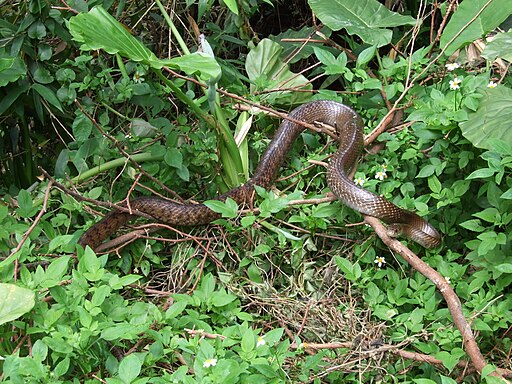Superregnum: Eukaryota
Cladus: Unikonta
Cladus: Opisthokonta
Cladus: Holozoa
Regnum: Animalia
Subregnum: Eumetazoa
Cladus: Bilateria
Cladus: Nephrozoa
Superphylum: Deuterostomia
Phylum: Chordata
Subphylum: Vertebrata
Infraphylum: Gnathostomata
Megaclassis: Osteichthyes
Cladus: Sarcopterygii
Cladus: Rhipidistia
Cladus: Tetrapodomorpha
Cladus: Eotetrapodiformes
Cladus: Elpistostegalia
Superclassis: Tetrapoda
Cladus: Reptiliomorpha
Cladus: Amniota
Classis: Reptilia
Cladus: Eureptilia
Cladus: Romeriida
Subclassis: Diapsida
Cladus: Sauria
Infraclassis: Lepidosauromorpha
Superordo: Lepidosauria
Ordo: Squamata
Subordo: Serpentes
Infraordo: Caenophidia
Superfamilia: Colubroidea
Familia: Colubridae
Subfamilia: Colubrinae
Genus: Elaphe
Species: Elaphe carinata
Subspecies: E. c. carinata – E. c. deqenensis – E. c. yonaguniensis
Name
Elaphe carinata (Günther, 1864)
Type locality: China.
Synonyms
Phyllophis carinata Günther, 1864: 298
Phyllophis carinata — Günther, 1888: 170
Elaphe carinata — Stejneger, 1898
Coluber phyllophis Boulenger, 1891: 280
Coluber phyllophis Boulenger, 1894: 55
Coluber (Elaphis) phyllophis — Müller, 1895: 203
Spaniopholis Souliei Mocquard, 1897
Spaniopholis kreyenbergi Müller, 1907
Elaphe carinata — Stejneger, 1907: 308
Elaphe osborni Schmidt, 1925
Coluber camillo-schneideri Vogt, 1927
Elaphe carinata — Smith, 1943
Elaphe carinata — Schulz, 1996
Elaphe carinata — Utiger et al., 2002
References
Günther, A. 1864. The Reptiles of British India. London (Taylor & Francis), xxvii + 452 pp.
Stejneger, Leonhard H. 1907. Herpetology of Japan and adjacent territory. Bull. US. Natl. Mus., Washington, 58: xx, 1-577.
Schulz, K. D. 1996. Eine Monographie der Schlangengattung Elaphe Fitzinger. Bushmaster, Berg (CH): 1–460.
Links
Elaphe carinata at the New Reptile Database. Accessed on 02 sep 2008.
IUCN: Elaphe carinata (Least Concern)
Vernacular names
Deutsch: Gekielte Kletternatter, Stinknatter
English: Taiwan Stink Snake
日本語: シュウダ
Nederlands: Taiwanese stinkslang
中文: 王锦蛇
Elaphe carinata, the king ratsnake (also known as Taiwan stink snake), is a species of Colubrid snake found in Southeast and East Asia.
Description
Elaphe carinata is a large snake with total length up to 240 cm (7.9 ft). The other common names "stink snake" or "stinking goddess" refer to this species' highly developed post-anal glands which, when the snake is picked up, are frequently emptied, with a very strong, bad odour.[1]
Elaphe carinata is an active, predatory snake that eats everything from beetles to birds to snakes, with particular preference for the latter.[1]
The common name of "king ratsnake" refers to its habit of eating other snakes, including venomous species such as the Chinese cobra and the sharp-nosed viper. It suffocates its prey by constriction, similar to the hunting technique of boas and pythons. It also preys on rodents and other small animals.
There is some concern among herpetoculturists that the king ratsnake may actually be more closely related to the kingsnakes of the genus Lampropeltis than to its current taxonomic family of the ratsnakes (Elaphe). This is due in part to the dietary habits of the king ratsnake, in particular its preference for ectothermic prey such as snakes and lizards, and to the physical structure of the head, which is far less distinct than that of most rat snakes and closely resembles the elongated head and indistinct neck structure of the kingsnakes. In actuality, there is very little direct genetic relationship between the two genera. They share much more in common genetically with other Eurasian rat snakes such as the Russian rat snake (Elaphe schrenkii) and the Japanese rat snake (Elaphe climacophora). They may also share a common lineage with the genera Coelognathus, Gonyosoma and Orthriophis. External morphological characteristics and behavior alone are generally not considered reliable taxonomic keys to classifying relationships between species, as the majority of current classification is based on DNA evidence. The superficial resemblance to American kingsnakes is more likely an example of convergent evolution, much like the similarities between the South American emerald tree boa (Corallus caninus) and the Indo-Australian green tree python (Morelia viridis).
The king rat snake is also uncommonly found in the exotic pet trade.
Distribution: China, northern Vietnam, Taiwan, Japan (Ryukyu Islands).[2]
Use
Elaphe carinata is one of major species in snake trade in China, particularly in skin trade but also of live animals;[3] it is the most commonly available snake in restaurants.[1][4]
References
Hans Breuer & William Christopher Murphy (2009–2010). "Elaphe carinata". Snakes of Taiwan. Retrieved 15 October 2012.
Elaphe carinata at the Reptarium.cz Reptile Database. Accessed 15 October 2012.
Zhou, Z.; Jiang, Z. (2004). "International trade status and crisis for snake species in China". Conservation Biology. 18 (5): 1386–1394. doi:10.1111/j.1523-1739.2004.00251.x.
Corn Snakes and other Rat Snakes, Richard D. Bartlett, copyright 1996, Barron's Educational Series
Retrieved from "http://en.wikipedia.org/"
All text is available under the terms of the GNU Free Documentation License


